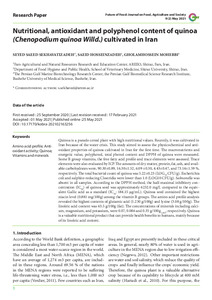Aufsatz

Nutritional, antioxidant properties and polyphenol content of quinoa (Chenopodium quinoa Willd.) cultivated in Iran
Abstract
The quinoa is pseudocereal plant that has nutritional value. Recently, It was cultivated in iran because of water crisis. This study aimed to assess the physicochemical and antioxidant properties of quinoa cultivated in Iran for the first time. The macronutrients and energetic value, polyphenol, total phenol content and DPHH of quinoa were measured. Some B group vitamin, the free fatty acid profile was assessed by HPLC and GC-mass separately. The trace elements were also evaluated by ICP. The amounts of dry matter, protein, fat, ash, and available carbohydrates were, 90.33±0.89, 16.30±1.52, 6.09 ±0.30, 4.43±0.47, and 73.14±1.59 percent, respectively. The total bacterial count of quinoa was 5.22±0.23 (LOG10 CFU.g-1). Escherichia coli and sulphite-reducing clostridia were lower than 1.0 (LOG10 CFU.g-1). Salmonella was absent in all samples. According to the DPPH method, the IC50 of quinoa seed was approximately 6232.0 mg.L−1 compared to the equivalent Gallic acid as a standard (IC50: 184.15 μg.mL−1). Also, the quinoa seed contained the highest level of niacin (0.881 mg/100g) among the vitamin B groups. The analysis of the amino acid profile revealed the highest contents of glutamic acid (1.230 g/100g) and lysine (3.08 g/100g). The concentrations of minerals including calcium, magnesium, and potassium were respectively (0.07, 0.086 and 0.35 g/100g). Quinoa is a valuable nutritional product that can provide health benefits to the human, mainly because of its linoleic acid content.
Citation
In: Future of Food: Journal on Food, Agriculture & Society Vol. 9 / No. 2 (2021-05-25) eissn:2197-411XCollections
Vol 09, No 2 (2021) (Future of Food: Journal on Food, Agriculture & Society // The Future of Food Journal: Journal on Food, Agriculture & Society)Citation
@article{doi:10.17170/kobra-202102163256,
author={Sekhavatizadeh, Seyed Saeed and Hosseinzadeh, Saeid and Mohebbi, Gholamhossein},
title={Nutritional, antioxidant properties and polyphenol content of quinoa (Chenopodium quinoa Willd.) cultivated in Iran},
journal={Future of Food: Journal on Food, Agriculture & Society},
year={2021}
}
0500 Oax
0501 Text $btxt$2rdacontent
0502 Computermedien $bc$2rdacarrier
1100 2021$n2021
1500 1/eng
2050 ##0##http://hdl.handle.net/123456789/12944
3000 Sekhavatizadeh, Seyed Saeed
3010 Hosseinzadeh, Saeid
3010 Mohebbi, Gholamhossein
4000 Nutritional, antioxidant properties and polyphenol content of quinoa (Chenopodium quinoa Willd.) cultivated in Iran / Sekhavatizadeh, Seyed Saeed
4030
4060 Online-Ressource
4085 ##0##=u http://nbn-resolving.de/http://hdl.handle.net/123456789/12944=x R
4204 \$dAufsatz
4170
5550 {{Iran}}
5550 {{Quinoa}}
5550 {{Eigenschaft}}
5550 {{Ernährung}}
5550 {{Vitamin}}
5550 {{Spurenelement}}
7136 ##0##http://hdl.handle.net/123456789/12944
<resource xsi:schemaLocation="http://datacite.org/schema/kernel-2.2 http://schema.datacite.org/meta/kernel-2.2/metadata.xsd"> 2021-06-25T11:00:25Z 2021-06-25T11:00:25Z 2021-05-25 doi:10.17170/kobra-202102163256 http://hdl.handle.net/123456789/12944 eng Namensnennung 4.0 International http://creativecommons.org/licenses/by/4.0/ amino acid profile antioxidant activity polyphenol content quinoa trace element 630 Nutritional, antioxidant properties and polyphenol content of quinoa (Chenopodium quinoa Willd.) cultivated in Iran Aufsatz The quinoa is pseudocereal plant that has nutritional value. Recently, It was cultivated in iran because of water crisis. This study aimed to assess the physicochemical and antioxidant properties of quinoa cultivated in Iran for the first time. The macronutrients and energetic value, polyphenol, total phenol content and DPHH of quinoa were measured. Some B group vitamin, the free fatty acid profile was assessed by HPLC and GC-mass separately. The trace elements were also evaluated by ICP. The amounts of dry matter, protein, fat, ash, and available carbohydrates were, 90.33±0.89, 16.30±1.52, 6.09 ±0.30, 4.43±0.47, and 73.14±1.59 percent, respectively. The total bacterial count of quinoa was 5.22±0.23 (LOG10 CFU.g-1). Escherichia coli and sulphite-reducing clostridia were lower than 1.0 (LOG10 CFU.g-1). Salmonella was absent in all samples. According to the DPPH method, the IC50 of quinoa seed was approximately 6232.0 mg.L−1 compared to the equivalent Gallic acid as a standard (IC50: 184.15 μg.mL−1). Also, the quinoa seed contained the highest level of niacin (0.881 mg/100g) among the vitamin B groups. The analysis of the amino acid profile revealed the highest contents of glutamic acid (1.230 g/100g) and lysine (3.08 g/100g). The concentrations of minerals including calcium, magnesium, and potassium were respectively (0.07, 0.086 and 0.35 g/100g). Quinoa is a valuable nutritional product that can provide health benefits to the human, mainly because of its linoleic acid content. open access Sekhavatizadeh, Seyed Saeed Hosseinzadeh, Saeid Mohebbi, Gholamhossein Iran Quinoa Eigenschaft Ernährung Vitamin Spurenelement publishedVersion eissn:2197-411X No. 2 Future of Food: Journal on Food, Agriculture & Society Vol. 9 false 336 </resource>
The following license files are associated with this item:
Namensnennung 4.0 International


